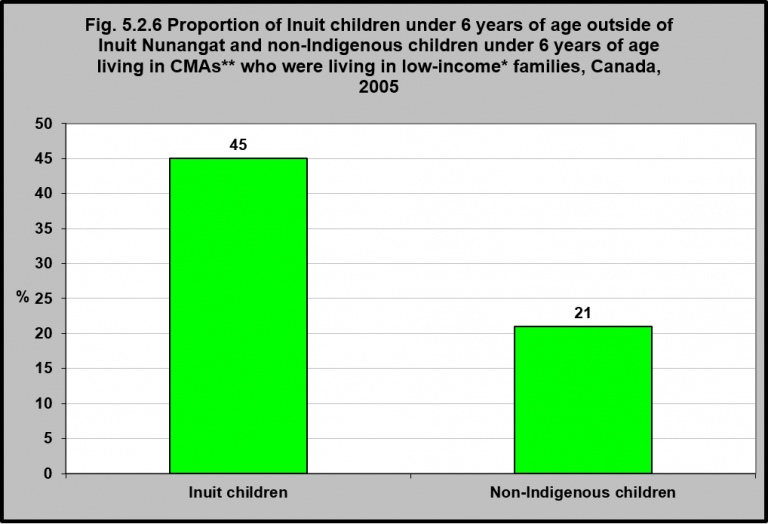Proportion of Inuit children under 6 years of age outside of Inuit Nunangat and non-Indigenous children under 6 years of age living in CMAs who were living in low-income families, Canada, 2005

Notes:
Income here refers to total income from all sources including employment income, income from government sources, pension income, investment income and any other money income received during the calendar year 2005 by persons 15 years of age and over.
*Low income before tax cut-offs (LICOs) – Income levels at which families or persons not in economic families are expected to spend 20 percentage points more than average of their before tax income on food, shelter and clothing. Economic families in the Yukon Territory, Northwest Territories and Nunavut and on Indian reserves were excluded as the low income cut-offs are based on certain expenditure- income patterns which are not available from survey data for the entire population.
**Census metropolitan areas (CMA) are formed by one or more adjacent municipalities centred on area (known as the urban core). A Census metropolitan area (CMA) must have a total population of at least 100,000 of which 50,000 or more must live in the urban core. Urban non-census metropolitan areas (non-CMA) are smaller urban areas with a population 100,000.
Source: CICH graphic created using data adapted from Statistics Canada – Catalogue no. 89-634-X 16. Aboriginal Children’s Survey, 2006: Family, Community and Child Care. http://www.statcan.gc.ca/pub/89-634-x/89-634-x2008001-eng.pdf
In 2006, there were 7,000 Inuit children under the age of six living throughout Canada.1 The majority (84%) lived in Inuit Nunangat2 with the remaining 16% living outside Inuit Nunangat.1
In 2005, almost half (45%) of Inuit children outside of Inuit Nunangat under 6 living in census metropolitan areas (CMAs) were living in low-income families.
This was a little more than double that for non-Indigenous children under six living in CMAs (21%).
1Statistics Canada. Inuit Children Under Six Years Old. http://www.statcan.gc.ca/pub/89-634-x/2008004/article/6500048-eng.htm -accessed November 15, 2017.
2Inuit Nunangat is the homeland of Inuit of Canada. It is comprised of four Inuit regions: Nunatsiavut (northern coastal Labrador), Nunavik (northern Quebec), the territory of Nunavut and the Inuvialuit region (northern Northwest Territories). These regions collectively encompass the area traditionally occupied by Inuit in Canada. Statistics Canada. 2016. Inuit: Fact Sheet for Inuit Nunangat. Catalogue no. 89-656 X2016014. http://publications.gc.ca/collections/collection_2016/statcan/89-656-x/89-656-x2016014-eng.pdf -accessed November 15, 2017.
Implications
Like off-reserve First Nations and Métis children, Inuit children under 6 years of age living in large urban centres/census metropolitan areas (CMAs) are also considerably more likely to be living in low-income families (more than twice as likely) compared to non-Indigenous children.
